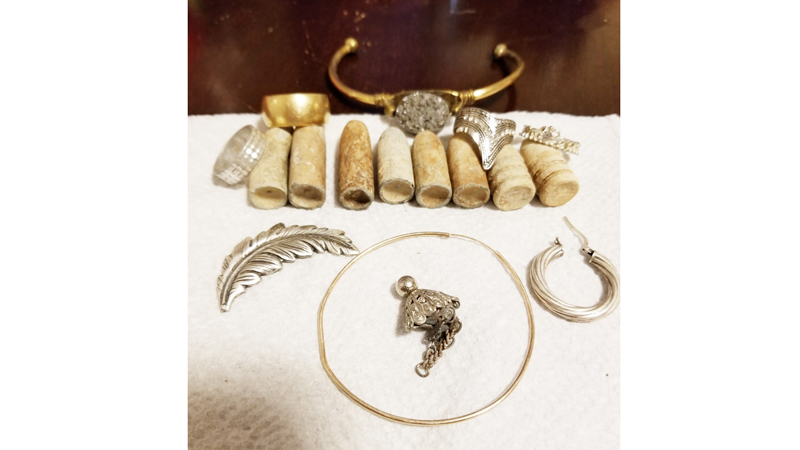River Parish Metal Detecting digs up the past
Published 1:00 am Wednesday, December 11, 2019

- Pictured are some of the relics discovered by the River Parish Metal Detecting group.
LAPLACE — Paul Milner says metal detecting is a lot like fishing — you never know exactly what you will bring to the surface. History of past generations lies only inches beneath the grass in St. John the Baptist Parish and beyond, and the new River Parish Metal Detecting group is eager to unearth unexpected relics.
In some cases, metal detecting isn’t a link to the past, but a way to find items lost in the present. While vacationing in Panama City Beach over the summer, Milner met a couple that had scoured the sand for two days in search of a lost engagement ring.
Within 10 minutes of putting his metal detector to the test, Milner found it.
Trending
Milner is part of the River Parish Metal Detecting group, along with Robert Stringer of LaPlace.

Robert Stringer of LaPlace leads two men from Ohio around City Park for a metal detecting adventure.
Stringer is new to the metal detecting world, but it’s a hobby he has quickly become passionate about. He received his first metal detector for Father’s Day 2019 after taking an interest in the “Hoover Boys” metal detecting YouTube series.
“We go to City Park in New Orleans, and we do home permissions in the River Parishes,” Stringer said. “This past week, we got a permission in Convent to do the old Jefferson College that was built in the early 1800s. We found quite a few relics.”
Among those relics was Stringer’s favorite find thus far, an old flint lock to a Civil War era gun. He also unearthed old coins and some Civil War bullets, which he was able to identify from researching the era.
“The most common Civil War bullets were what they call a three-ringer,” Stringer said. “They will have three rings that go around the bullet at the bottom.”
His ideal “unicorn find” would be a Civil War belt buckle or breast plate. However, he has not come across those yet.
Trending
The best coins he’s found include a 1925 Standing Liberty quarter and an 1855 French coin that was discovered at the Old Holy Cross School in New Orleans.
Another great find came from a residential commission in Garyville. Buried a few inches underground in the yard was a World War II medal.
The deepest item his Equinox 600 metal detector located was 25 inches underground.
“The top rules of metal detecting are get permission and cover your holes,” Stringer said. “We don’t make real big, deep holes. Most of what we find is from one inch to seven inches underground.”

Robert Stringer’s son, Cruz Stringer, holds some Civil War bullets he and his father found through metal detecting.
Milner became interested in metal detecting to learn more about the history of the region. He’s learned about the supplies brought up and down the river and how settlements were formed. One area he is eager to explore is West Fifth Street because it was one of the first neighborhoods established in LaPlace.
“I like researching the local areas and learning about the history in the areas. I like finding out what’s in the ground and what people have left behind,” Milner said.
“You’d be surprised what people leave as in coins dropped, rings lost.”
It’s also a hobby beneficial to anyone who enjoys the outdoors, according to Milner.
“It gets you out of the house, and it also releases a lot of anxiety and stress,” he said. “It’s about meeting new people and networking.”
Milner and Stringer have met up with friends from Amite and New Orleans to search for Civil War bullets in City Park and Audubon Park. They even connected with tourists who had traveled all the way from Ohio to metal detect in Louisiana.
The duo is hoping to meet more explorers in St. John the Baptist, St. James and St. Charles parishes. People are welcome to take their own metal detectors along for the ride. Alternatively, residents who have lost an item in their yard or those who are just curious to see what is out there can invite the River Parish Metal Detecting Group to their home.
Stringer said the purpose isn’t to dig unsightly holes and take anything they can find.
“When we’re asking for home permissions, I think a lot of people are scared,” Stringer said. “We are very honest and family-oriented people. The homeowners are more than welcome to keep anything we find. We just like finding it.”
Stringer enjoys bringing his 5-year-old with him during excursions for some father-son bonding time.
Due to advances in technology, Stringer and Milner can identify whether the item they have detected is made out of iron, nickel or gold before they ever dig a shovel into the ground.
Those who are interested in metal detecting, or for more information, please either message RPMD River Parish Metal Detecting on Facebook or email rpdm2019@yahoo.com.






